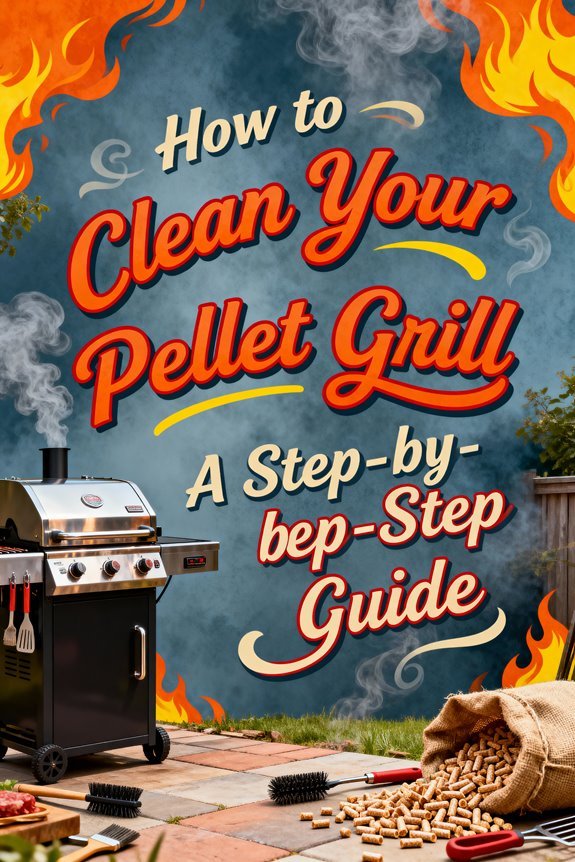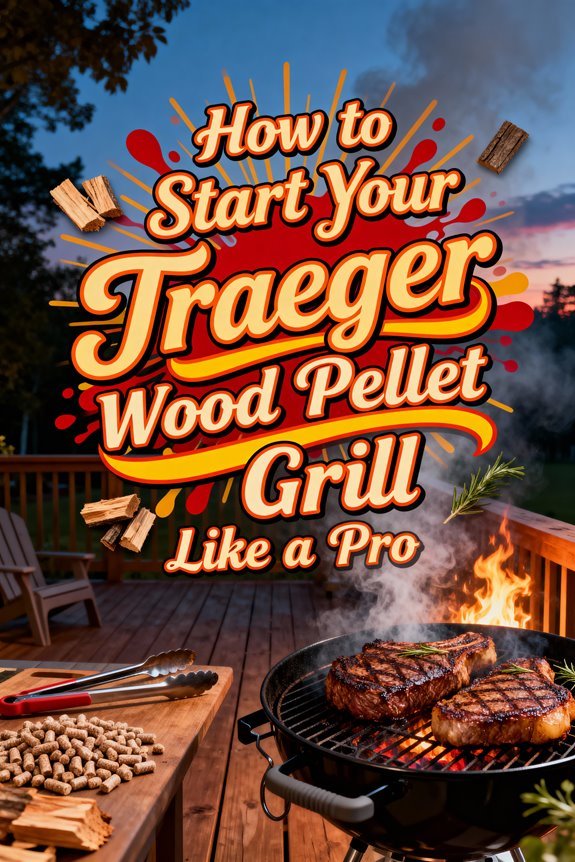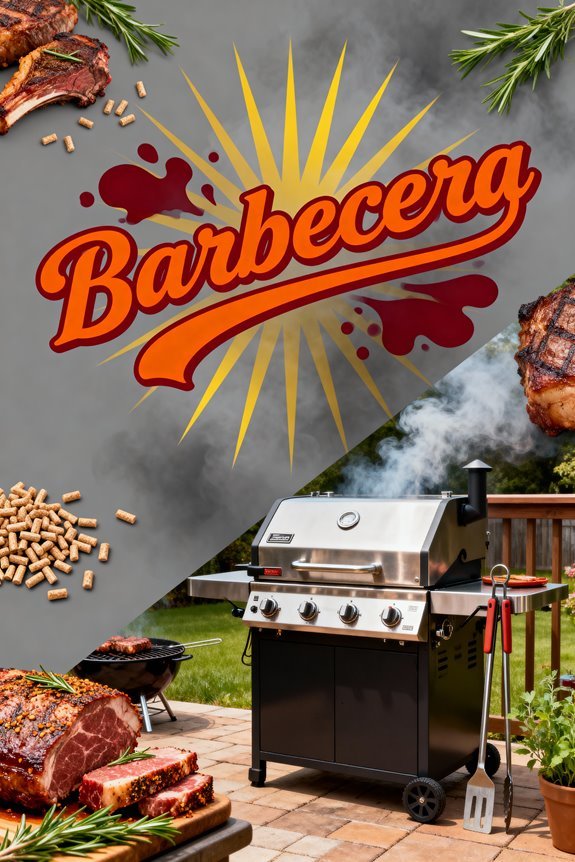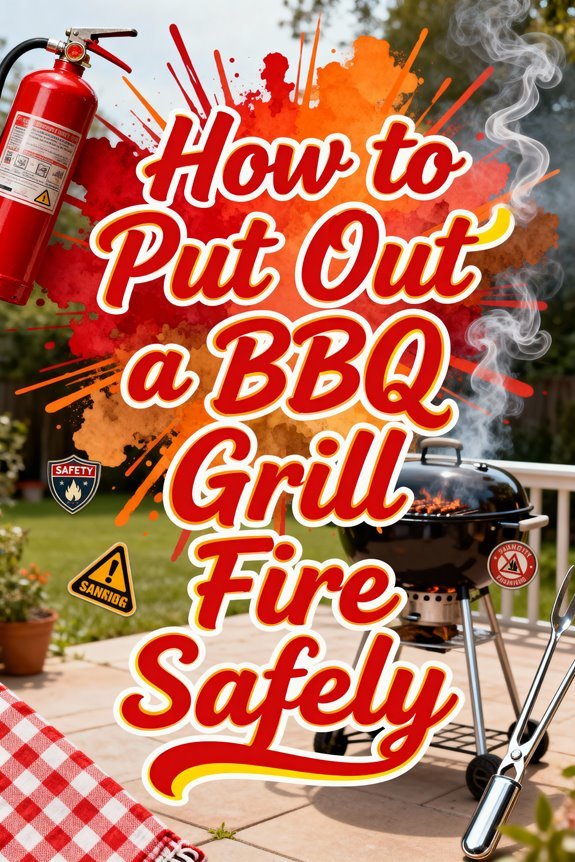To use your Masterbuilt electric smoker, start by assembling and seasoning it at 275°F for three hours to create a protective coating. When you’re ready to smoke, preheat to maximum temperature for 30-45 minutes, then adjust to 225-250°F for most meats. Add wood chips through the side loader for steady smoke, and monitor internal temperatures with the digital probes. Keep the door closed to maintain heat, and always position your smoker on level ground. Master these basics, and you’ll unveil a world of perfectly smoked dishes.
Essential Parts and Assembly Steps
A successful smoking experience starts with understanding your Masterbuilt Electric Smoker‘s essential components. The 1200W heating element serves as the heart of your unit, while the digital control panel lets you manage temperature and timing with precision. You’ll find multiple cooking grates, a water pan for moisture control, and a wood chip tray for that authentic smoky flavor. The smoker can accommodate up to four probes for monitoring different cuts of meat simultaneously. Regular natural cleaning methods will help maintain your smoker’s performance and prevent buildup of harmful residues. For best results when smoking steaks, maintain a consistent temperature between 450-500°F to achieve optimal flavor development.
When assembling your smoker, start by checking component compatibility and laying out all parts. First, attach the legs and any included shelves, then install the control panel and heating element according to your model’s specifications. Finally, position the cooking grates, water pan, and chip tray in their designated slots. Before your first smoke, plug in the unit and run a test cycle to guarantee everything’s working properly.
Seasoning Your Smoker for First-Time Use
Before you start smoking delicious meats and vegetables, seasoning your Masterbuilt Electric Smoker is essential for prime performance and flavor. Start by wiping down all interior components with a damp cloth, then reassemble everything inside the smoker, including racks and water bowl.
One of the most significant seasoning techniques involves running your smoker at 275°F for three hours. During the first two hours, let it heat without wood chips to remove manufacturing residues. For the final hour, add hickory or your preferred wood chips to create that signature smoky coating. Ensuring all components are properly installed will maximize the effectiveness of the seasoning process.
This initial seasoning process creates a protective layer that prevents rust and enhances your smoker’s longevity. Once seasoned, your smoker will be ready to maintain consistent temperatures between 225°F and 250°F for perfect results. For ideal smoker maintenance, remember to lightly oil the racks after cooling and consider periodic re-seasoning to maintain peak performance. Following proper seasoning ensures your smoker can maintain the 30-minute rule for smoking times per pound of meat.
Setting Up for Your First Smoke
Three key steps will guarantee your first smoking session starts perfectly: proper assembly, thorough setup, and careful preheating. Start your smoker placement tips by selecting a level, stable surface away from flammable materials. Follow your pre-smoke checklist by attaching all components securely – legs, handles, control panel, racks, and drip pan. Always ensure your smoker is connected to a properly grounded outlet. Similar to cooking bratwurst indoors, maintaining consistent temperature is crucial for optimal results.
Once assembled, verify the chip loader, wood tray, and heating element are correctly installed. Don’t add water to the bowl during initial setup; you can introduce it later if needed. Set your temperature to maximum (usually 275°F) and allow 30-45 minutes for preheating. Add ½ cup of wood chips, but don’t open the door during this process. Once preheated, you’re ready to load your ingredients and begin your smoking journey. For optimal results when smoking chicken, maintain 225 degrees Fahrenheit for tender, flavorful meat.
Temperature Control Basics
Understanding temperature control is the cornerstone of successful electric smoking. Your Masterbuilt smoker offers temperature ranges from 100°F to 275°F, with 225°F-250°F being ideal for most meats. You’ll want to master preheating techniques to guarantee consistent results – start by running your smoker at maximum temperature for 30-45 minutes before adding food. Setting the temperature 10°F higher than desired helps maintain stable smoking conditions throughout the cooking process.
For precise control, digital models let you adjust in 5°F increments using the up/down buttons, while analog models use a simple dial system. Keep in mind that frequent door opening will disrupt your temperature stability, so resist the urge to peek too often. In cold weather, you’ll need extra preheating time, and it’s smart to shelter your smoker from wind. Similar to achieving crispy fish skin on a grill, maintaining consistent temperature is crucial for perfect results. Remember to maintain proper airflow by never covering racks with foil. Just like with grilling ribs, achieving tender results requires careful monitoring of internal temperature until your meat reaches the proper doneness.
Wood Chip Selection and Smoking Flavors
When it comes to achieving perfect smoke flavor, selecting the right wood chips can make or break your smoking experience. For your Masterbuilt electric smoker, you’ll want to use properly sized wood chips rather than chunks or logs to guarantee ideal smoke production. Start with classic combinations like hickory for beef, apple for poultry, or pecan for pork. You can even create unique wood chip combinations to develop complex smoke flavors that’ll enhance your meats. Since electric smokers work best with small wood chips, they’re the perfect match for your Masterbuilt’s needs.
Remember to add dry chips through your smoker’s side loader to maintain consistent temperature, and watch for that perfect light blue smoke – it’s your signal that everything’s working right. Much like achieving low and slow cooking for the perfect grilled sandwich, don’t overload the chip tray; instead, replenish small amounts every few hours for clean, steady smoke that’ll give you the best results. For meats like Boston butt, plan on maintaining steady smoke for two hours per pound when cooking at 225°F to achieve tender, flavorful pulled pork.
Loading and Positioning Your Food
Proper food placement in your Masterbuilt Electric Smoker is essential for achieving mouthwatering results. When arranging your food, leave adequate space between pieces and the smoker walls to guarantee maximum heat and smoke circulation. Don’t overload the racks, as this can trap heat and lead to uneven cooking. For tender and juicy chicken breasts, smoke them at low temperatures for 2-3 hours. Position larger cuts of meat on the lower or middle racks where heat distribution is most stable, while delicate items can go on upper racks. For optimal cooking results, red meat should be placed on the top rack and fish on the bottom. When smoking fresh sausages, maintain a temperature between 225 to 250°F for best results. Use drip trays beneath your food to catch excess grease and make cleanup easier. For efficient food arrangement, consider using grill mats to prevent sticking. Keep the door closed during cooking except when absolutely necessary, and ensure your door latch is properly adjusted to prevent smoke from escaping through the seals.
Maintaining Proper Smoke Levels
Creating the perfect smoke level in your Masterbuilt Electric Smoker requires mastering the delicate balance of wood chips, temperature, and airflow. To achieve ideal smoke intensity, add high-quality hardwood chips every 30-45 minutes, using moderate amounts to prevent bitter flavors. Keep your smoker’s temperature between 225°F and 275°F, and maintain the vent opening at 50% or more for proper airflow. Your water pan adds steam during the smoking process to help maintain moisture levels.
For peak flavor balance, remember that smoke absorption peaks in the first 15-30 minutes, then gradually decreases. Don’t smoke beyond 4 hours, as this can overwhelm your food with harsh flavors. Keep your smoke light and consistent by monitoring the color and aroma. For enhanced results, spritz your meat occasionally with water or vinegar to improve smoke adhesion, and avoid opening the door frequently to maintain steady smoke production. For perfectly smoked chicken, plan on one hour cooking per pound of meat at 250°F to reach the ideal internal temperature. Just as with golden brown crust on grilled cheese, you’ll want to achieve an appealing color on your smoked meats.
Monitoring Cooking Progress
Successful smoking relies on precise monitoring of your cooking progress using your Masterbuilt’s digital controls and temperature probes. Your smoker’s digital panel lets you set temperatures and cooking times up to 24 hours, while the red indicator lights show when the heating element is active. For effective temperature tracking, use your smoker’s built-in meat probe to monitor internal temperatures without opening the door. The smoker’s analog dial control makes temperature adjustments simple and intuitive for beginners. Avoid frequently opening the smoker door as this can disrupt the steady temperature range needed for proper smoking.
Make cooking adjustments based on visual cues through the window – look for thin, blueish smoke and developing color on the meat’s surface. Cross-check chamber temperatures with an external thermometer and adjust settings if needed. Keep the smoker between 225°F-275°F for consistent results. For perfect chicken, ensure the meat reaches an internal temperature of 165°F in the thickest part of the thigh before removing. Remember to factor in weather conditions that might affect performance, and set reminders as you approach estimated completion times.
Cleaning After Each Use
Regular maintenance of your Masterbuilt Electric Smoker begins with a thorough cleaning after each smoking session. Before you start, verify the smoker is unplugged and completely cool, then gather your essential cleaning tools: soapy water, steel wool, a BBQ scraper, and paper towels. Using a stainless steel sponge will help prevent damage while effectively removing grease and residue. For optimal cleaning results, heat your smoker to 400 degrees Fahrenheit before cleaning to help soften stubborn grime.
Start by removing all components, including racks, drip pans, and chip trays. Wash these parts in soapy water, using steel wool for stubborn residue. Place removed components in hot soapy water for 10 minutes to loosen buildup. For interior scrubbing, create a 50/50 mixture of water and apple cider vinegar. Spray this solution inside the smoker and use your BBQ scraper to remove deposits. Avoid harsh chemicals that could damage your smoker’s surfaces. Once everything’s clean and dry, reassemble the components and run the smoker for an hour to re-season the interior.
Safety Tips and Best Practices
Safe operation of your Masterbuilt Electric Smoker requires three essential safety considerations: electrical precautions, proper placement, and fire safety protocols. Always plug your smoker into a grounded outlet and keep it away from water or rain exposure. As part of your emergency procedures, maintain a fire extinguisher nearby and never leave the unit unattended during operation. Like with charcoal grilling, proper heat zone setup is crucial for safe and effective cooking. Just as with propane equipment, following the valve safety rules is essential when connecting any gas components.
Position your smoker on level ground outdoors, away from any flammable materials or enclosed spaces. Don’t move the smoker while it’s hot or operating, and guarantee proper ventilation at all times. Your safety equipment should include heat-resistant gloves when handling the unit. Keep children and pets away during use, and never cover racks with foil, as this can cause dangerous heat buildup. Monitor temperature consistently and follow manufacturer guidelines for wood chip quantities. After use, allow the smoker to cool completely before moving or cleaning it.







